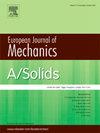Size effects in 3D-printed polymeric lattices under three-point bending: Manufacturing, testing, and modelling
IF 4.2
2区 工程技术
Q1 MECHANICS
引用次数: 0
Abstract
Architected lattice structures often exhibit pronounced size effects that challenge conventional modelling strategies. This contribution presents a combined experimental and numerical investigation of size effects in 3D-printed lattice beams under three-point bending. Specimens with triangular and square unit cells, manufactured using affordable Fused Deposition Modelling (FDM) with polyethylene terephthalate glycol (PETG), are tested at different lattice refinements while maintaining constant overall dimensions and solid volume fraction. The experiments reveal clear size-dependent behaviour in terms of stiffness, strength, and failure modes. To model these effects, three numerical strategies are employed: Direct Numerical Simulations (DNS), and multi-scale approaches based on first- and second-order computational homogenisation (FE2).DNS provides accurate predictions but is computationally expensive for fine lattices. Second-order FE2 captures size effects more efficiently, particularly when micro-scale periodic boundary conditions are applied, although it may overestimate responses for coarser lattices. This work critically assesses the accuracy and applicability of each modelling approach, providing valuable insight into the design and simulation of architected structures where scale-dependent behaviour is significant.

尺寸效应的3d打印聚合物晶格下三点弯曲:制造,测试和建模
体系结构晶格结构经常表现出明显的尺寸效应,挑战传统的建模策略。本文提出了三维打印点阵梁在三点弯曲下尺寸效应的实验和数值研究。使用经济实惠的聚对苯二甲酸乙二醇酯(PETG)熔融沉积模型(FDM)制造的三角形和方形单元格样品,在不同的晶格精细化下进行测试,同时保持恒定的总体尺寸和固体体积分数。实验揭示了在刚度、强度和破坏模式方面的明确的尺寸依赖行为。为了模拟这些影响,采用了三种数值策略:直接数值模拟(DNS)和基于一阶和二阶计算均匀化(FE2)的多尺度方法。DNS提供了准确的预测,但对于精细的格来说,计算成本很高。二阶FE2更有效地捕获尺寸效应,特别是当应用微尺度周期性边界条件时,尽管它可能高估较粗晶格的响应。这项工作批判性地评估了每种建模方法的准确性和适用性,为建筑结构的设计和模拟提供了有价值的见解,其中规模依赖行为是重要的。
本文章由计算机程序翻译,如有差异,请以英文原文为准。
求助全文
约1分钟内获得全文
求助全文
来源期刊
CiteScore
7.00
自引率
7.30%
发文量
275
审稿时长
48 days
期刊介绍:
The European Journal of Mechanics endash; A/Solids continues to publish articles in English in all areas of Solid Mechanics from the physical and mathematical basis to materials engineering, technological applications and methods of modern computational mechanics, both pure and applied research.

 求助内容:
求助内容: 应助结果提醒方式:
应助结果提醒方式:


